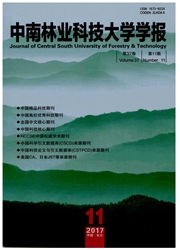

 中文摘要:
中文摘要:
西北内陆山区径流变化受到多种因素的影响,其中冬、春季甚至初夏季节降雪消融直接影响着径流的形成过程和变化。本文采用降雪消融样地监测法、三角量水堰自记水位计和容积测定法,对祁连山北坡2002-2011年气温、日照、降雪、积雪消融及流域径流进行长期监测与研究。结果表明:(1)祁连山排露沟流域5~9月份为雨季,10~4月份为雪季。(2)雪季降水占全年降水量的11.2~25.6%,平均为17.69%,降雪平均厚度为40.65 cm。(3)乔木林内积雪量占灌丛林的84.54%,阴坡积雪量比阳坡高8.36%。积雪消融量平均为0.184~0.526 mm/d,乔木林积雪消融占灌丛林的78.72%,占阴坡草地的37.66%,占阳坡草地的32.61%;灌丛林积雪消融量占阴坡草地的47.45%,占阳坡草地的41.09%;阴坡积雪消融量占阳坡的34.98%,即阴坡积雪时间比阳坡长63.12%。(4)流域月径流深为0.28~23.19 mm,年径流深为83.45 mm。积雪消融形成的融水径流深为4.60 mm,占年总径流量的5.51%。本文对于揭示水源涵养功能机理及其流域产流机制具有重要意义,并为将来开展祁连山水源涵养功能评估和人工增雨雪项目提供基础数据和参考。
 英文摘要:
英文摘要:
The runoff seasonal dynamics affected by many factors in northwest inland mountainous of China, including snow melt in winter and spring or early summer season directly affects the runoff formation and changes. By using the sample melting snow monitoring method, triangle measuring weir determination of watershed runoff hydrograph and volume method, the long-term monitoring and study on temperature, sunshine, snowfalls, now melt and runoff in the northern slope of Qilian mountains from 2002 to 2011 were investigated. The results show that (1) It is rainy season from May to September, and it is snow season from October to April in Pailugou watershed in Qilian mountains. (2) The snowfall accounts for 11.2% to 25.6% of the annual precipitation, the average is 17.69%, and the average thickness is about 40.65 cm, the snowfall of arbor forests accounts for 84.54% of bush forests; the snowfall in the shady slope is 8.36% more than in sunny slope. (3) The amount of snow ablation was at the range of 0.184 - 0.526 mm/d, and snow ablation of arbor forest accounted for 78.72% of bush forest, for 37.66% of shady slope grassland, for 32.61% of sunny slope grassland; snow ablation of shrub forests accounted for 47.45% of shady slope grassland, for 41.09% of sunny slope grassland; the snow ablation of shady slope grassland accounted for 34.98% of sunny slope, that is to say that the snow time of shady slope grassland was more 63.12% than the time of sunny slope. (4) The basin monthly runoff depth was 0.28 - 23.19 ram, the annual runoff depth was 83.45 mm. Meltwater runoff formation of snow ablation depth was 4.60 mm, accounting for 5.51% of the total annual runoff. The findings have great significances for future development of the runoff yield mechanisms, for revealing the function of water conservation and its producing mechanism, for assessing the function of water conservation in Qilian mountains and providing basic data and references of artificial enhancement rain and snow research projects.
 同期刊论文项目
同期刊论文项目
 同项目期刊论文
同项目期刊论文
 期刊信息
期刊信息
